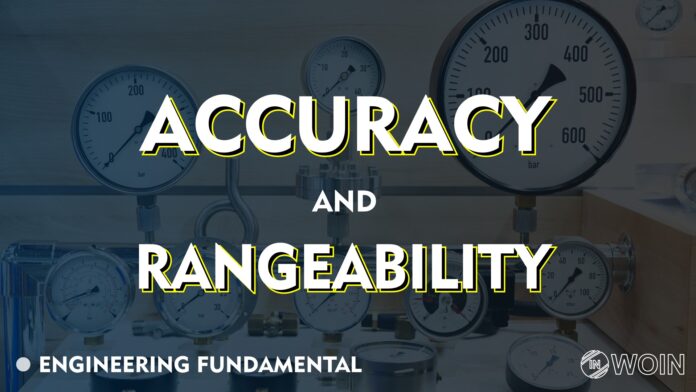In this article, I will give a complete explanation of accuracy and rangeability.
Accuracy and Rangeability are the most important terms in engineering and at the same time also create confusion. And we know that precise control is only possible if we have accreted measurements of the control variables.
Humans can’t measure anything absolutely. We are only able to measure different values that are generated by different devices.
1. Accuracy
accuracy of any sensor is a function
B G Liptek
of the precision of the reference it was calibrated against.
There are multiple terms used by manufacturers to define the accuracy (Actually Inaccuracy) of the instruments they manufacture.
The accuracy term is used rather loosely and does not clearly state the maximum error of the instrument in its whole measuring range.
We do have standards and international definitions that are relevant to measurement and accuracy,
But the Organisation Internationale de Métrologie Légale (OIML) did publish a guide, commonly referred to as VIM (International Vocabulary of Basic and General Terms in Metrology).
Understanding Accuracy Statement
> For accuracy if the vendor is given 1% or any other value for any instrument first, we need to check what is the basis of this accuracy.
Because vendors are representing accuracy in different ways for their products like %FS (Full Scale), %AR (Actual Reading), and %URV (Upper Range Valve)
Accuracy is given in 1% AR (Actual Reading) then we have to understand that if a particular reading is 100, the true value of that measurement would fall between 100 ± 1 and if the true value is 10, the measurement would fall between 10 ± 0.1.
Accuracy is given in 1% FS (Full Scale) then we have to understand that if a full-scale range of the instrument is 0-100, the reading is 100, and the true value of that measurement would fall between 100 ± 1.
and if the true value is 10, the measurement would fall between 10 ± 1. In short, if a device is 1% FS, for example, the error at 10% of reading will be 10% AR. And it is unacceptable to practice.
> the Vendor needs to show Rangeability (Turndown ratio) that states the Measurement range over which the stated accuracy in % AR (% of actual reading) is guaranteed.
>All Vendors need to provide linearity, rangeability, and hysteresis errors
Also, they also need to include the error contributions caused by drift, temperature effects, over range, power supply, humidity, RFI, and vibration or list them in their broad error statement.
> Vendor also needs to provide reference devices detail where the instrument is calibrated against.
2. Rangeability
In simple language, the Turndown Ratio (rangeability) is defined as the usable range of an instrument in which the instrument can measure variables with stated accuracy.
You know that the orifice flow meter has a Turndown Ratio (Rangeability) is 3:1 it shows that the orifice meter is not able to measure value below 33.3% of the full-scale reading accurately.
This same statement works for all turndown ratios like if any flow meter has a turndown ratio of 4:1 it shows the meter is not able to measure value below 25% of the full-scale reading accurately.
References
- Bender, S., What is turndown ratio in gas measurement, What is turndown ratio for a gas flow meter? – Linc Energy Systems
- Eng.Tips.com, Rangeability problem, Rangeability problem – Measurement & control instrumentation engineering – Eng-Tips
- Tutelman, D., Precision, accuracy, resolution, Precision, Accuracy, and Resolution (tutelman.com)
EndNote
I hope all this information and resources on Accuracy and Rangeability will help you in the future,
And I hope these resources are helping you in your career and in your professional life.
I want to create more and more high-quality content like this. Please consider supporting me on by me a coffee platform.
If you have any suggestions then feel free to ask in the comments and through email id.
you want to write an article on the website, please contact us by this mail id: contact@worldofinstrumentation.com
And if you like this post, you can also like my previous article on Ultrasonic vs Radar Level Measurement.
And you can also follow our LinkedIn group which is specially made for sharing information related to Industrial Automation and Instrumentation.


